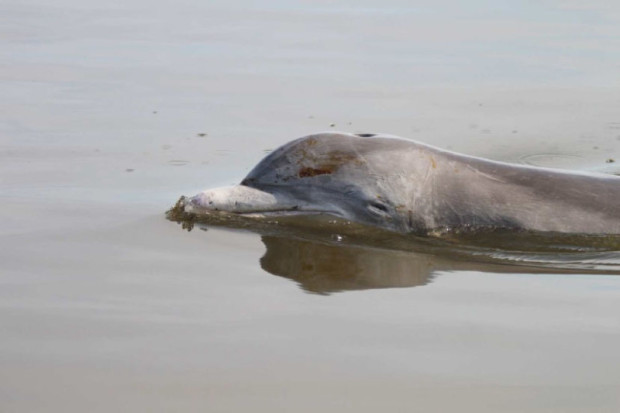We have much more to do and your continued support is needed now more than ever.
Study: Dolphins In Oiled Areas of Gulf “Very Sick”
A new peer-reviewed study makes the strongest case to date that the oil from the Deepwater Horizon disaster is harming dolphins in the Gulf of Mexico.
As part of the official investigation into impacts of the Deepwater Horizon disaster, a team of scientists did comprehensive physicals on dolphins in Barataria Bay in 2011, a heavily-oiled area of the Louisiana coast. Nearly half the dolphins studied were very ill; seventeen percent of the dolphins were not expected to survive.
According to the National Oceanic and Atmospheric Administration, the lead agency conducting the research:
The publication details the first evidence that dolphins in heavily oiled areas are exhibiting injuries consistent with toxic effects observed in laboratory studies of mammals exposed to petroleum hydrocarbons. The dolphin health study concludes that the health effects seen in the Barataria Bay dolphins are significant and likely will lead to reduced survival and ability to reproduce.
The findings were deeply troubling to Dr. Lori Schwacke, the lead author of the study and a veteran of a number of similar studies of dolphin health. She stated, “I’ve never seen such a high prevalence of very sick animals.”

…moderate to severe lung disease was five times more likely in the Barataria Bay dolphins, with symptoms including lung masses and consolidation. The researchers also found that 25 percent of the Barataria Bay dolphins were significantly underweight and the population overall had very low levels of adrenal hormones, which are critical for responding to stress.
In a statement quoted in the Times-Picayune, a BP spokesperson argued these symptoms “have been seen in other dolphin mortality events that have been related to contaminants and conditions found in the northern Gulf.”
But the study’s lead researchers argued that these symptoms are in fact quite unusual and are unlikely to be related to other, more common contaminants found in the Gulf :
We found that the levels of these pollutants in Barataria Bay dolphins were actually lower than the levels in Sarasota Bay dolphins. The levels from Barataria Bay dolphins were also low compared to previously reported levels in dolphins from a number of other coastal sites in the southeastern U.S. Therefore, we don’t think that the health effects we saw can be attributed to these other pollutants that we looked at.
NOAA has been investigating an ongoing wave of dolphin deaths across the northern Gulf of Mexico since February 2010. This is the longest such investigation in the past two decades and it includes the greatest number of stranded dolphins ever found in the Gulf of Mexico.
![]() Make sure BP’s fines are used to restore habitat for dolphins and other wildlife in the Gulf!
Make sure BP’s fines are used to restore habitat for dolphins and other wildlife in the Gulf!





















